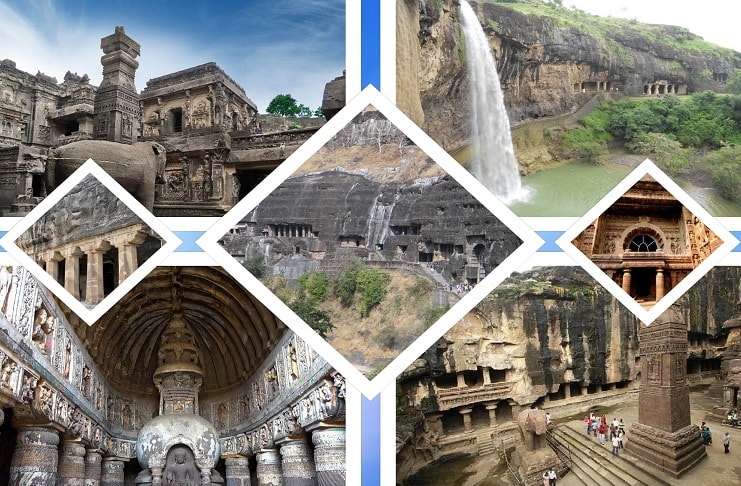Our Latest Blog

Ajanta & Ellora Caves: A Timeless Treasure of Ancient India
Ajanta & Ellora – Echoes in Stone
"Where stone breathes history, and art whispers stories of faith, devotion, and genius."
Overview:
Located near the city of Aurangabad in the state of Maharashtra, the Ajanta and Ellora Caves are two of the most stunning and historically significant UNESCO World Heritage Sites located in the geographical context of India. These extraordinary ancient rock-cut caves are world-famous for their pure architectural brilliance, intricately beautiful sculptures and sacred artworks depicting the profound traditions of Buddhism, Hinduism and Jainism.
Location
- The Ajanta Caves are located about 105 kilometers from the city of Aurangabad, amidst the picturesque Sahyadri hills.
- The Ellora Caves are just 30 kilometers from the city of Aurangabad.
- Both the sites are well connected by road, rail and air from Aurangabad.
History and Significance:
Ajanta Caves
- Date from the 2nd century BCE to the 6th century CE.
- Buddhist monks dedicated to their religious beliefs built 30 caves in two phases.
- Known throughout history for their beautiful fresco paintings, amazing murals and inspiring chaityas, also called prayer rooms.
- Explains and illustrates the tremendous changes and developments that took place in Indian art over the centuries.
Ellora Caves:
- Constructed between the 6th and 10th centuries CE.
- Highlights 34 caves:
- 12 Buddhist caves
- 17 Hindu caves
- 5 Jain caves
- Home to the Kailash Temple (Cave 16), a monolithic wonder carved from a single piece of rock.
Spiritual and Cultural Significance:
- Ajanta focuses on Buddhist philosophy and depictions of Jataka stories.
- Ellora demonstrates religious tolerance as it depicts three religions coexisting.
- The caves were not only natural formations but also ancient monasteries, sacred temples and important places of worship.
Architectural and Artistic Wonders
Ajanta:
- Use of natural colours on the artworks.
- The wall frescoes show elaborate details as they vividly depict many key events and instances from the life of Buddha.
- A meditative atmosphere with detailed sculptural work.
Ellora:
- The Kailash Temple, an architectural wonder, is a near replica of the sacred Mount Kailash; it is incredibly twice the size of the legendary Parthenon in Athens.
- Hindu gods and goddesses, cosmic events, and mythological scenes depicted in art.
- Jain caves exhibit extreme detail and asceticism.
Travel and Weather Guidance:
- The best time to plan visiting is during the months from November to March.
- Not advisable: Monsoon (Jul–Sep) since slippery roads and huge rains can cause accidents.
Recommendations:
- Wear casual shoes.
- Pack water and sunscreen.
- Guided tours are strongly recommended.
Amenities and Accessibility
- Wheelchair facilities provided at Ellora (partial).
- Tourist Information Centres, toilets, restaurants, and souvenir shops at both sites.
Visitor Statistics:
- Ajanta receives around 350,000 visitors annually.
- Ellora attracts nearly 700,000 visitors each year.
Nearby Attractions:
- Daulatabad Fort
- Bibi Ka Maqbara (Mini Taj Mahal)
- Grishneshwar Jyotirlinga Temple
- Panchakki (Water Mill)
Must-Try Local Food:
- Aurangabadi Naan Qalia
- Misal Pav
- Sabudana Vada
- Puran Poli
- Kharwas (Milk Pudding)
Other interesting facts:
- The Ajanta Caves, known for their exquisite rock-cut architecture and beautiful ancient paintings, were rediscovered in 1819 by a British officer who was on a tiger hunting expedition at the time.
- It took over 100 years and 7,000 laborers to complete the Kailash Temple.
- These amazing caves are a true engineering marvel, especially when we consider the lack of contemporary tools and technology we have today.
"The Ajanta and Ellora caves are much more than just carefully and intricately carved into the hard surfaces of rocks; rather, they are the very essence and carved soul of the deep spirituality and boundless imagination that existed in ancient India."